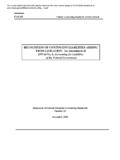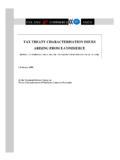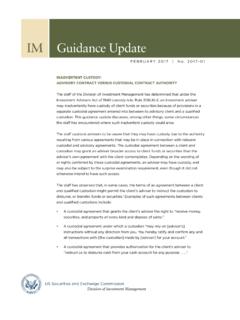Transcription of GETTING STRONGER, BUT TENSIONS ARE RISING - oecd.org
1 1 GETTING STRONGER, BUT TENSIONS ARE RISING Summary The world economy will continue to strengthen in 2018 and 2019, with global GDP growth projected to rise to about 4%, from in 2017. Stronger investment, the rebound in global trade and higher employment are helping to make the recovery increasingly broad-based. New tax reductions and spending increases in the United States and additional fiscal stimulus in Germany are key factors behind the upward revision to global growth prospects in 2018 and 2019. Inflation remains low, but is likely to rise modestly. Still-elevated risk-taking and high debt levels in many countries raise financial vulnerabilities. Monetary policy normalisation could also result in greater volatility of exchange rates and capital flows, particularly in emerging market economies. Medium-term growth prospects remain much weaker than prior to the financial crisis, reflecting less favourable demographic trends and a decade of sub-par investment and productivity.
2 Economic policies face several challenges: A gradual normalisation of monetary policy is needed, but to a varying degree across the major economies. Continued clear communication about the path to normalisation is essential to minimise the risk of financial market disruptions. Fiscal policy choices should avoid being excessively pro-cyclical and be clearly focused on measures that strengthen the prospects for sustainable and more inclusive medium-term growth. Structural reform efforts should be revived, seizing the opportunity of the stronger economy to help secure a more robust recovery of productivity, investment and living standards. Safeguarding the rules-based international trading system will help to support growth and jobs. Governments should avoid escalation and rely on global solutions to resolve excess capacity in the global steel industry. 2 2017 Interim EO projectionsDifference from November EOInterim EO projectionsDifference from November , Germany Aggregate using moving nominal GDP w eights at purchasing pow er G20 aggregate does not include European Union countries w ho are not members in their ow n Fiscal years, starting in Interim Economic Outlook Forecasts March 2018 Real GDP growthYear-on-year % increase20182019 Note: Dif f erence f rom November 2017 Economic Outlook in percentage points, based on rounded f igures.
3 3 The economic outlook is improving Global GDP growth is estimated to have been in 2017, the strongest outcome since 2011, with positive growth surprises in the euro area, China, Turkey and Brazil. Industrial production, investment and trade growth have rebounded, with global trade growth reaching an estimated 5 per cent in 2017, and business and consumer confidence remain elevated. Improved cyclical conditions are now being reflected in commodity markets and in labour markets. Investment and trade growth have rebounded Note: G20 investment aggregate excludes China and Saudi Arabia due to data unavailability. The euro area aggregate includes only Germany, France and Italy. World trade is measured as goods and services trade volumes in constant US dollars. Source: OECD Economic Outlook Database; and OECD calculations. Stronger GDP growth is being accompanied by solid job creation, with the OECD-wide unemployment rate having finally fallen below the pre-crisis level.
4 Even so, the recovery in employment remains uneven; the employment rates of older workers (aged 55 and above) have risen sharply in recent years, but prime-age and youth employment rates are only at, or still below, pre-crisis levels in many countries, including the United States. Income and employment gains remain uneven in the OECD Note: The OECD employment rate of each age group is the ratio of the number of employed people to the working age population in the age group. The income series are averages of the 17 OECD member countries for which data are available over the full period. Source: OECD Short-Term Labour Market Statistics; OECD Income Distribution Database; and OECD calculations. Labour markets have become more polarised, with a decline in the share of middle-skill jobs relative to jobs with higher or lower skill levels. Despite steady declines in unemployment, wage growth generally 4 remains weak, contributing to popular dissatisfaction with economic performance.
5 Many households have seen little growth in real disposable incomes over the past decade, particularly those with low incomes. Growth is set to strengthen further in the next two years The world economy will continue to strengthen over the next two years, with global GDP growth projected to reach almost 4% in both 2018 and 2019. Growth in the United States, Germany, France, Mexico, Turkey and South Africa is projected to be significantly more robust than previously anticipated, with smaller upward revisions in most other G20 economies. The tax reductions and public spending increases announced over the past three months in the United States, together with a substantially easier fiscal stance in Germany, are key factors behind the upward revision to global growth prospects in 2018 and 2019. Ongoing improvements in business investment in the major economies should be reflected stronger global trade growth.
6 Prospects for investment are also somewhat stronger than previously expected in commodity-producing economies, reflecting the higher level of global commodity prices. GDP growth prospects have been revised up in advanced and emerging economies Note: GDP in constant prices. Fiscal year data for India. The G20 aggregate does not include the European Union countries who are not members in their own right. G20 emerging economies include Argentina, Brazil, China, India, Indonesia, Mexico, Russia, Saudi Arabia, Turkey and South Africa. Source: OECD Economic Outlook database. Key features of the projections in the G20 economies are: In the United States, GDP growth is projected to pick up to between 2 -3 per cent over 2018-19. Tax reductions and higher government expenditure reinforce the momentum in domestic demand from strong confidence, solid job creation, past gains in household wealth and the rebound in oil production. Taken together, the new US fiscal measures could add between - percentage point to US GDP growth both this year and next, with modest positive demand spillovers for other economies (see Box).
7 Gradual monetary policy normalisation is set to continue, bringing higher long-term interest rates, as the labour market tightens further and wage growth and inflationary pressures pick up. Growth in the euro area is set to remain robust and broad-based at between 2-2 per cent over 2018-19. Accommodative monetary and fiscal policies, improving labour markets and high levels of business and consumer confidence are all helping to boost demand. Investment is also becoming increasingly supportive, on the back of strong global demand and favourable financing 5 conditions. Growth is set to remain solid in Germany, helped by additional fiscal easing projected in both 2018 and 2019, and France, helped by the impact of recent reforms, but is set to continue at a more moderate pace in Italy. Growth surprised on the upside in China in 2017, helped by a strong rebound in exports, but is set to soften to just below 6 per cent by 2019.
8 Macroeconomic and regulatory policies are gradually becoming more restrictive, the working age population is now declining and credit conditions are less expansionary. Regulatory efforts are continuing to reduce financial risks, deal with overcapacity in some sectors and improve environmental quality. Fiscal policy is now broadly neutral, but additional measures could be implemented if output growth were to slow more sharply. GDP growth in Japan is set to remain at around 1 per cent in 2018 before easing to around 1% in 2019, supported by improved export growth, especially in Asian markets, and the additional spending announced in the recent supplementary budget. Strong corporate profitability should continue to underpin the recovery in business investment, but private consumption is likely to remain subdued if wage and income growth is modest. The global trade rebound, particularly for semi-conductors, is also helping to support demand in Korea.
9 GDP growth is projected to remain around 3% over 2018-19, with the higher minimum wage and stronger social welfare spending supporting household incomes and spending. GDP growth in the United Kingdom is projected to ease to a little over 1 per cent this year and 1% in 2019. High inflation continues to damp real household income growth and consumer spending, and business investment is slowing, amidst continued uncertainty about the future relationship between the United Kingdom and the European GDP growth in Canada is projected to soften to around 2 per cent in 2018 and 2% in 2019. Macroeconomic policies are gradually becoming less accommodative, but private consumption remains robust, strong employment growth is beginning to be reflected in wages, and firmer commodity prices should boost business investment. Strong commodity demand is also benefitting Australia, with GDP growth projected to pick up to around 3% over 2018-19.
10 Non-mining and infrastructure investment have strengthened, and improved terms of trade and solid job creation provide support for household incomes, despite still modest wage growth. In Mexico, fiscal and monetary policies are relatively tight, but strong global demand growth, resilient private consumption and reconstruction spending are all projected to support output growth in 2018-19. Robust domestic demand growth is projected to help underpin growth in India, Indonesia and Turkey over 2018-19. Growth in Turkey is projected to moderate from the exceptionally rapid pace seen in 2017 as government stimulus measures fade, but could remain at around 5% over 2018-19 given strong labour force growth and improved external demand. GDP growth is expected to strengthen in India to around 7 per cent and 7 per cent in FY 2018 and FY 2019 respectively, with strong private investment growth driving the rebound from the transitory effects of demonetisation and the introduction of the Goods and Services Tax.
















